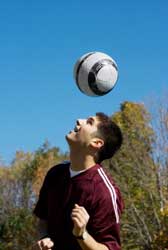Heading & Football
May 13 2008 | Articles

Basics
Whatever position you are playing in, your ability to head a ball is one very important skill that you should possess. The safest and the most effective part of the head that you can use is your forehead. That is why, in any playing activity, make it a point to get yourself into the best possible position while obtaining proper timing of your headers. As you are about to jump, keeping in mind that you focus your eyes on the ball. As you start to move into the line of flight, be sure to push of with both your feet.
As you jump, you can achieve power by:
• Bending your knees
• Arching your back
• Thrusting your head and your body forward on contact
• Keeping the muscles of your neck tensed
For balance, use your arms properly since you will normally be off the ground for most of the headers. Be careful not to raise your arms too high, or even wave them around, so that you will not be penalised by the referee. As much as possible, try to head the ball at the highest point of your jump.
Do not let the ball drop because if you do so, you are raising the chances of your opponent to beat you in the air. Use your forehead, just directly above your eyebrows, to head the ball. Always keep your eyes open and be positive as you are making contact with the ball.
Defensive
In the defensive area, the goal is to correctly head the ball as far away and as high from your main goal as possible. Instead of heading the ball into an area that is directly on the front of the goal, it is advised that you have to head the ball out on either sides of the goal.
As quickly as you can, get in line with the ball. That way, you can get it ahead of your opponent. You can also consider meeting the ball from a side-on position. This will allow you to create better power while providing you with reliable protection against your opponents, with lesser chances of clashing heads. You should also have to be really careful with your arms. Any push of the back of an opponent means penalties or those dangerous free kicks to be given away.
Make contact on the bottom part of the ball to power the ball upwards. Try also to arch your back to properly thrust your forehead into the ball.
Attacking
Try to work correctly on your attacking headers to send more chances into the goal and less over the bar. The key there is to head downwards and you can easily achieve that is to get over the ball. Direct the ball downwards to the bottom corners, usually the most difficult areas that a goalkeeper can defend. As quickly as you can, get into the line with the ball. Time your runs in order for you to get in front of your defender just as you are to meet the ball. If the cross or the path is deeper, take some few steps back away from the defender to create some space.
